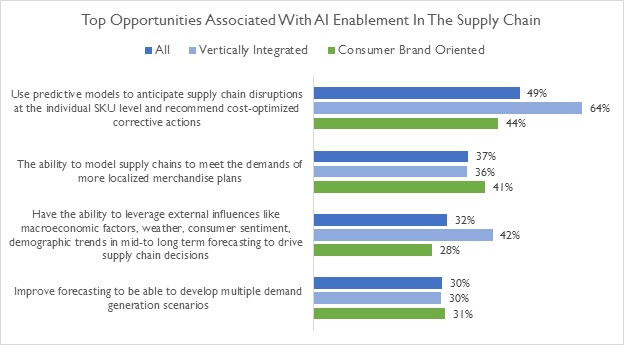AI In The Supply Chain: Agility vs. Efficiency
The COVID-19 crisis of 2020 has highlighted the value of using AI to build predictive models as an integral part of decision making. The question is, can the same modeling techniques be used by retailers to better anticipate and respond to risks and disruptions in both supply and demand? That is a question that RSR sought to get an answer to in the soon-to-be-released benchmark study, The Case For An AI-Enabled Retail Supply Chain, sponsorted by LLamasoft.
What we found is revealing.
The news coming out of the COVID-19 pandemic and the resultant shutdown showed that retailers and their suppliers were not well-prepared for the sudden spike in the volume of non-traditional orders that resulted from the crisis. Online shopping skyrocketed in grocery and general merchandise, but that led to dramatic delays in order fulfillment processes. In fashion retail, the pandemic has disrupted supply chains that were already stressed by soft consumer demand, increased direct-to-consumer shipments, punitive tariffs, social and climate change concerns, and demands for transparency.
While the challenges highlighted by the pandemic are not new, they are made more urgent by the current situation. It has taken retailers more than a decade to absorb changes in the customer-facing “demand” side of their businesses. On the “supply” side, most retailers have only recently begun to make the changes necessary to offer more localized and relevant value in the stores, to offer new direct-to-consumer options, and to be able to respond quickly to sudden changes in demand.
Retailers’ struggles with both the supply and the demand side of their businesses have triggered interest in AI-enablement. That interest is timely; many adjacent industries and even governmental agencies are already using AI-enabled modeling to perform both scenario planning and to accelerate the response to real time conditions (as has been evidenced by responses to the COVID-19 crisis). There are simply too many variables that affect both demand and supply for decision makers to handle manually – more automated responses to market conditions are increasingly viewed as necessary to help retailers perform better in a complex and volatile marketplace. Rules-based systems have not proven terribly helpful. Hence we find new interest in self-learning systems.
Efficiency vs. Agility
The retail supply chain as it exists today across many verticals was built primarily for operational excellence and economic advantage, not agility. An underlying assumption of retail supply chains over the past half-century was that consumers bought what retailers had to sell, i.e. the objective was to push as much of a product through the selling channel (principally the store) as possible. But today, consumers are empowered by a world of choices, and they revolt against what they perceive as “a sea of sameness”. They are also starting to revolt against environmental wastefulness (particularly apparent in apparel). Consumers demand relevant solutions to their lifestyle needs. A low price and ubiquitous product availability are no longer enough to win loyalty or sales even in hard times.
The new benchmark study reveals general agreement that rapidly changing consumer demand undercuts retailers’ ability to buy in the largest available quantities (average and under-performers are most concerned) and that omnichannel customer order fulfillment is driving up costs that can’t be recovered with higher retail prices. Retailers and their partners theoretically strive to keep supply and demand in equilibrium, but retailers know that fluctuations on either side will create a “new normal.” This drives interest in modeling as an integral part of planning and operations.
Modeling To Balance Supply And Demand
Next-generation analytics enabled by artificial intelligence and machine learning create their own set of opportunities, which are in turn the result of the vast new types data that are available to businesses today. The reason AI-enabled analytical capabilities are so important is that there are simply too many permutations of data for the human mind to process in any kind of a timely matter. The promise of AI-enablement is that new math-driven analysis makes it possible for businesses to develop predictive models which in turn enable automated decision making. About one-half of the retailers we queried clearly see the opportunity to use predictive models to automate corrective actions in response to supply chain disruptions, while approximately one-third of retailers see modeling to help keep sources of supply in better balance with ever-shifting demand (Figure).
Figure: An Emerging Understanding

Source: RSR Research, June 2020
Retailer responses in the study make it clear that “AI” is far from being generally accepted as a must-have capability. As is so often the case, many retailers seem to be waiting for “someone else” to develop the top use cases. That “someone else” appears to be over-performers (or “Retail Winners”, in RSR parlance). Considering the relative newness of AI as a viable solution for retailers of all shapes and sizes, the fact that something close to one-half of our respondents see AI as a top-three enabler to address supply chain issues is encouraging. But AI-enablement in the supply chain is certainly not a “done deal”.
AI Now
In an era of unpredictability, the ability to model potential outcomes becomes all that much more important. The study’s retail respondents show a moderate appetite to use predictive models to anticipate supply chain disruptions – tools that can also recommend cost-optimized corrective actions – but beyond that, it is clear that AI-enabled predictive models for such things as labor and transportation costs across the supply chain – or finding optimal DC-to-customer locations to lower costs while still satisfying customer needs – are not yet seen as must have technologies. There are genuinely powerful use cases of AI and ML being used in retail right now, changing the way retailers make critical decisions. AI is no longer a concept car – it’s real, and it’s available to retailers willing to sift through the hype to discover its most powerful right-now applications.
